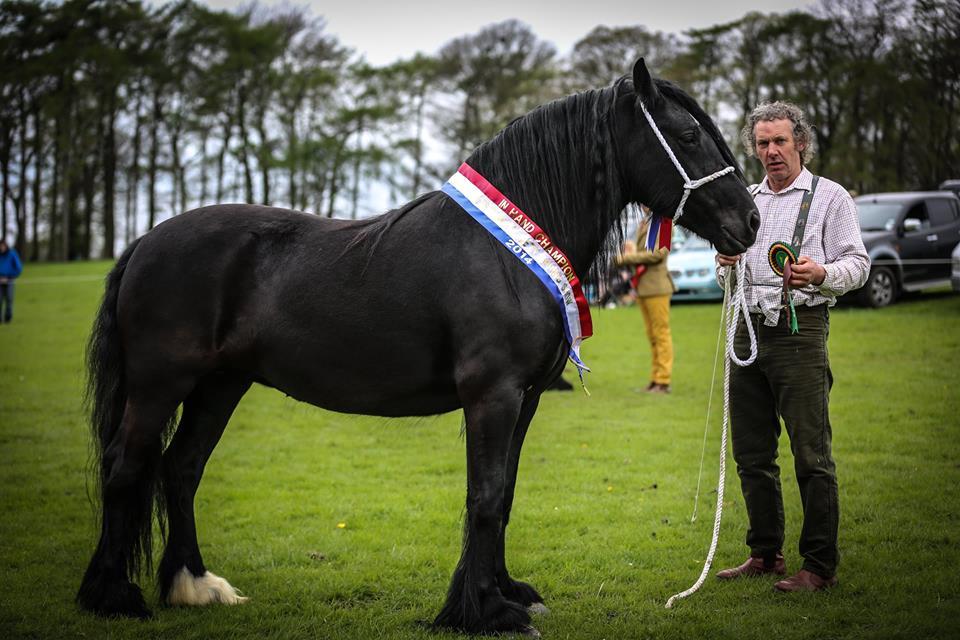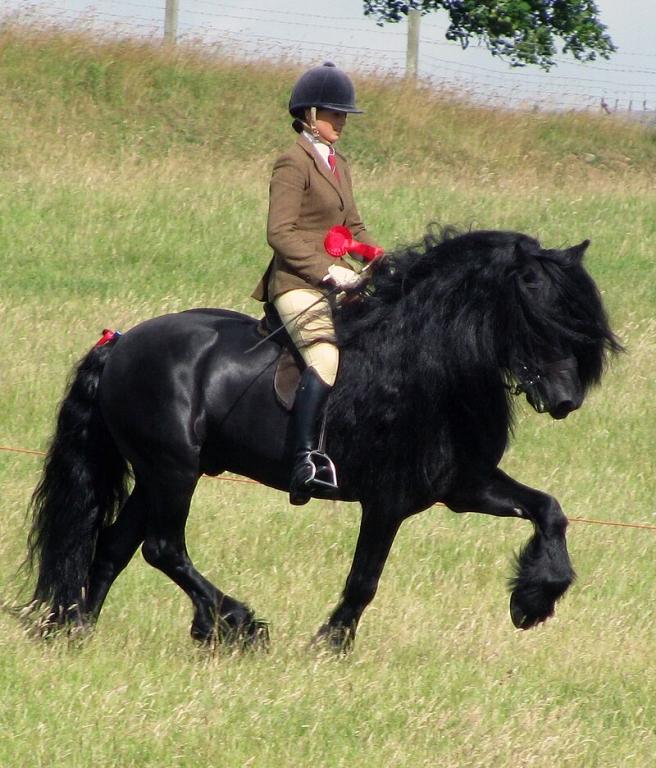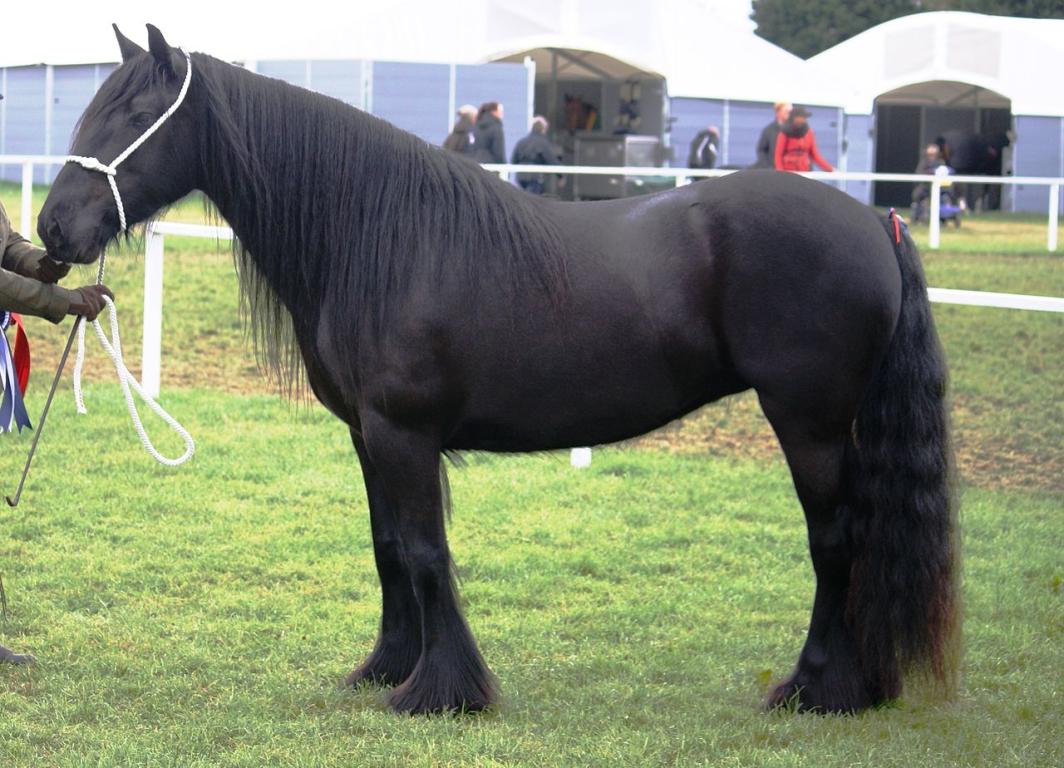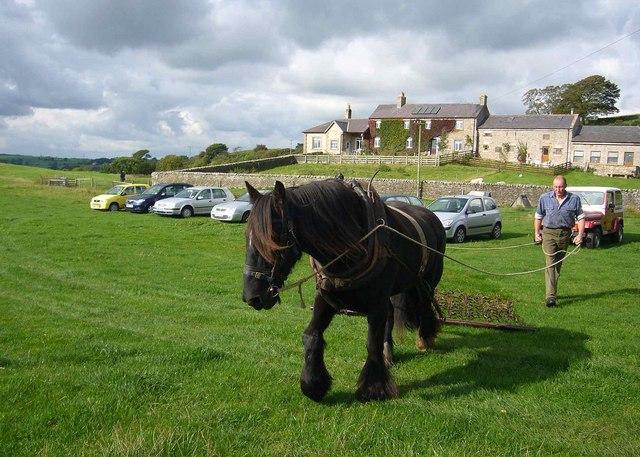
Continent: Europe
Country: United Kingdom
Weight: 400 – 500 kg
Height: 132 – 142 cm



The Dales Pony takes its name from the valleys (dales in English) that form its native breeding ground, located on the eastern slopes of the Pennines in northern England. It is traditionally associated with the regions of North Yorkshire, Cumberland, and Durham, particularly the valleys of the Tyne, Allen, Swale, and Tees.
Its most distant ancestors were Celtic ponies living in a semi-wild state, already present in this region during the Roman era. Archaeological excavations carried out in Ribchester (Lancashire) in 2009 uncovered equine remains from this period, confirming the long-standing presence of horses in the area. The Romans are believed to have brought horses similar to the Friesian, contributing to the breed’s characteristic black coat.
Over the centuries, the Dales was influenced by several breeds:
– Scottish Galloway: for speed and endurance.
– Norfolk Trotter and Thoroughbred: to lengthen stride and improve movement.
– Welsh Cob: for power and bone structure.
– Clydesdale (occasionally, in the 19th century): to increase draught strength, though this influence is minimal today.
Historically, the Dales Pony was an essential pack pony in the Pennine mining industry. It carried lead ore, iron, and coal over long distances, bearing loads of up to 110 kg and sometimes covering 80 km in a single day, in all weather conditions and over difficult terrain. This work shaped an extremely robust, enduring, and sure-footed pony qualities still present in the breed today.
The Dales Pony’s place of origin is located on the eastern slopes of the Pennines, in northern England, covering mainly:
– North Yorkshire
– Cumberland
– Durham
– as well as the valleys of the Tyne, Allen, Swale, and Tees.
Small herds still live in semi-feral conditions in these valleys, continuing a traditional hardy breeding system adapted to the climate and rugged terrain.
Outside the United Kingdom, the breed has been established in North America since the 1990s:
– Canada: first imports in 1991 (12 ponies), now with several active breeders in the English-speaking provinces.
– United States: first imports in 1994, followed by the creation of the Dales Pony Society of America (1999), which manages registrations in direct cooperation with the British stud-book.
In continental Europe, the breed’s presence remains marginal, with a few individuals in France, Belgium, and Germany, often bred by enthusiasts or for equestrian tourism.
The Dales Pony remains, overall, a limited-distribution breed, concentrated in its native areas and in North American studs, which justifies its critically endangered status according to the Rare Breeds Survival Trus
The Dales Pony represents a rare and valuable genetic heritage among the British “mountain and moorland” ponies. Selected over centuries for pack work, light draught, and trekking on difficult terrain, it has passed down to its descendants an exceptional combination of strength, endurance, and sure-footedness.
Genetic analyses confirm a common origin with the Fell Pony and a kinship with the Friesian, a legacy of ancient crossings probably introduced during the Roman era. There is also a more distant relationship with the Suffolk Punch.
The breed has one of the strongest bone structures in proportion to its size among all equines, giving it remarkable carrying and draught capacity. This advantage, combined with excellent hoof quality (broad, resilient blue-black horn), makes it a valuable genetic model for improving the hardiness and robustness of other equine lines in controlled crossbreeding programs.
However, the Dales is now listed as critically endangered by the Rare Breeds Survival Trust (fewer than 300 breeding mares in the UK in 2015).
Low genetic diversity and the prevalence of a serious hereditary disease, Foal Immunodeficiency Syndrome (FIS), require special care in breeding management. Genetic screening programs are now mandatory to limit high-risk matings and ensure the long-term viability of the breed.
Ancient and Medieval Origins :
The Dales Pony takes its name from the dales (“valleys”) of its native region, located on the eastern slopes of the Pennines in northern England. Its ancestors were Celtic ponies living in a semi-feral state, present in the area since Roman times.
Archaeological excavations carried out in Ribchester in 2009 uncovered equine remains from this period, suggesting the introduction of horses similar to the Friesian by the Romans, which may have contributed to the breed’s characteristic black coat.
From the Middle Ages to the 19th Century :
As early as the 14th century, the Dales was used as a pack pony to transport lead, iron, and coal from the Pennine mines to the east coast ports, covering up to 80 km per day with a 110 kg load.
From the late 17th century, the breed received influence from the Scottish Galloway, and in the 18th and 19th centuries from the Norfolk Trotter, Thoroughbred, and Welsh Cob. These crossbreeds improved speed, size, and gait quality, while preserving the pony’s original hardiness.
Early 20th Century and World Wars :
The Dales Pony Improvement Society was founded in 1916 to protect the breed and establish its stud-book. During World War I and World War II, many Dales were requisitioned by the army for artillery and transport. Many never returned, and some were slaughtered for meat.
After 1945, the population reached a critical low, with only 50 individuals registered between 1945 and 1947.
Rescue and Revival :
In the 1960s, the Dales Pony Society was reorganized. Crossbreeding with three Fell Pony stallions was authorized to broaden the genetic base. This conservation program was a success, allowing the population to stabilize by the 1970s.
Contemporary Period :
From the 1990s, the breed was exported to North America (Canada in 1991, United States in 1994), where local associations now collaborate with the British stud-book.
Despite this expansion, the Dales remains critically endangered according to the Rare Breeds Survival Trust due to its small numbers and the threat of Foal Immunodeficiency Syndrome (FIS). Today, it is valued for equestrian tourism, driving, and trekking, carrying forward the qualities that built its reputation.
The Dales Pony is known for its balanced temperament, controlled liveliness, and strong bond with humans, making it a reliable, versatile, and easy-to-handle companion in a variety of contexts.
General Temperament :
- Calm and steady – very little reaction to sudden stimuli, making it a safe pony for outdoor riding.
- Intelligent – learns quickly, understands commands, and can adapt to various purposes with minimal training.
- Willing and hard-working – has a genuine love of effort, giving its best, especially when encouraged through a trust-based relationship.
- Energetic yet manageable – possesses power and spring without ever becoming difficult to control.
Work Behaviour :
- Enduring and courageous, willingly covering long distances, even on technical terrain or in challenging conditions.
- Sure-footed, excelling in trekking, driving, and outdoor work.
- Consistent in effort, never shirking work, and maintaining a steady rhythm without tiring quickly.
Relationship with Humans :
- Affectionate and sociable, forming a strong bond of trust with its rider or driver.
- Ideal for families, animal-assisted therapy centres, or alternative riding schools thanks to its gentle and reassuring temperament.
- Can be slightly independent or stubborn when bored, but never aggressive.
The Dales Pony combines the mental resilience of rustic breeds with quick intelligence and a cooperative nature. It is a trustworthy, honest, and generous pony, equally suited to work or leisure, and valued for its calm and respectful relationship with people.
The Dales Pony remains a rare and endangered breed, classified as critically endangered in the United Kingdom, with fewer than 300 registered breeding mares in 2015. Its low genetic diversity and the presence of Foal Immunodeficiency Syndrome (FIS) require strict breeding management, with mandatory testing of breeding stock and careful selection to avoid inbreeding.
The preservation prospects rely on:
– Promoting its versatile qualities (trekking, driving, light agricultural work), which appeal to those seeking a hardy, sure-footed, and enduring pony.
– Expanding its presence outside the UK, particularly in North America, where active breed associations maintain ties with the British stud-book.
– Developing equestrian tourism and traditional demonstrations, which help raise awareness of the breed among the general public.
– Maintaining semi-feral herds in the Pennines, to preserve its natural abilities and adaptation to its native environment.
The future of the Dales Pony will depend on the ability of breeders and associations to broaden the genetic base while preserving the historic traits that have built its reputation. Without sustained conservation efforts, the breed could see its numbers drop below the critical threshold in the coming decades.
The Dales Pony is a robust, hardy, and naturally healthy breed, shaped by centuries of selective breeding in the harsh conditions of the English mountains. It has few major health issues, though certain points require attention, particularly due to its current low genetic diversity.
Health Strengths :
- Excellent hardiness – well adapted to cold, wet, or changeable climates.
- Very strong and healthy hooves, rarely prone to laminitis or abscesses.
- Low maintenance needs – resistant to common diseases and not very susceptible to parasites if properly managed.
- Longevity – often remains active until 25 years or older with good care.
The Dales Pony is a naturally sound and resilient pony, perfectly suited to an outdoor lifestyle and low-maintenance management. The main concern today lies in genetic management and screening for FIS (Foal Immunodeficiency Syndrome), to ensure the long-term health of this rare and valuable breed.